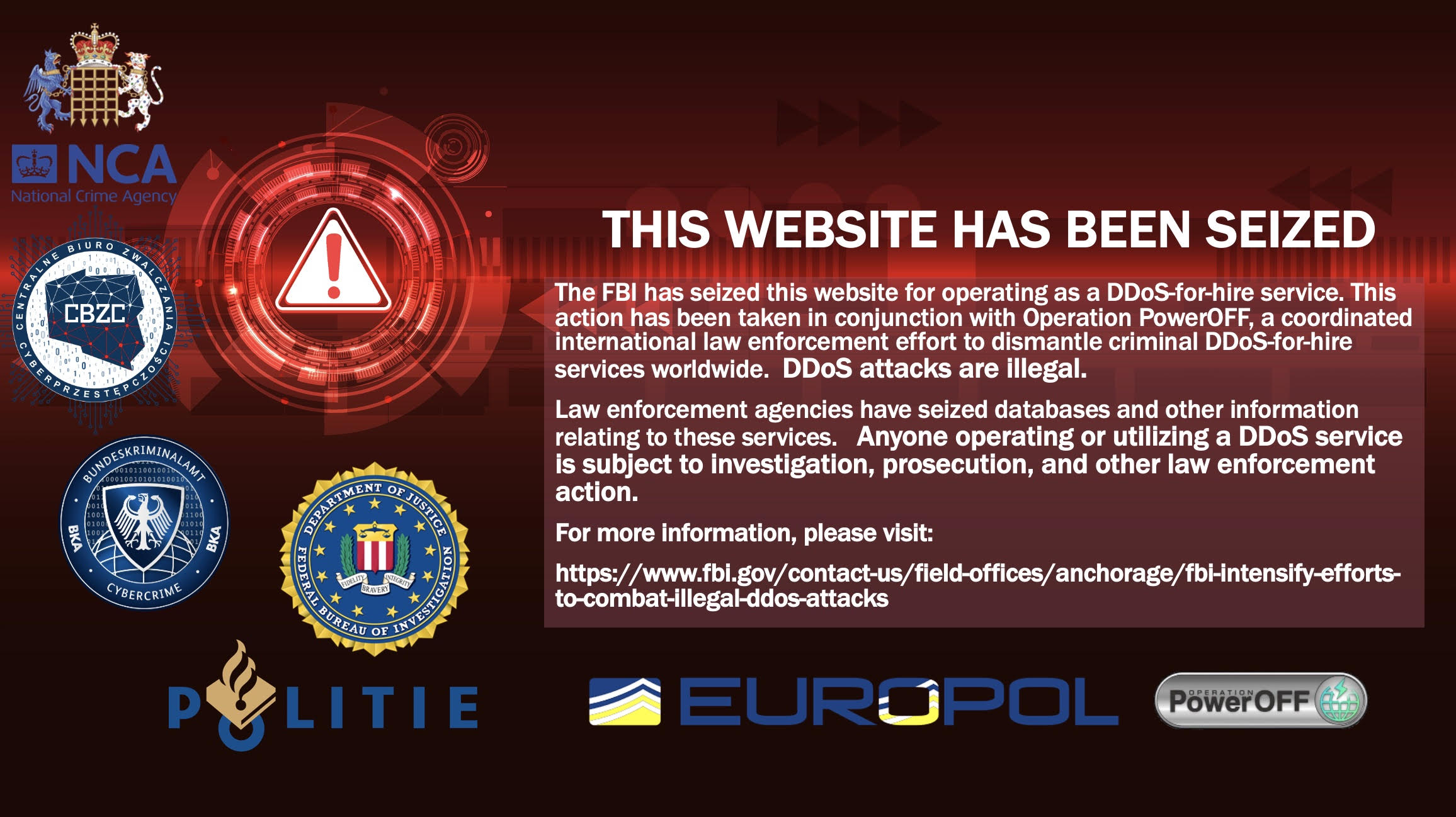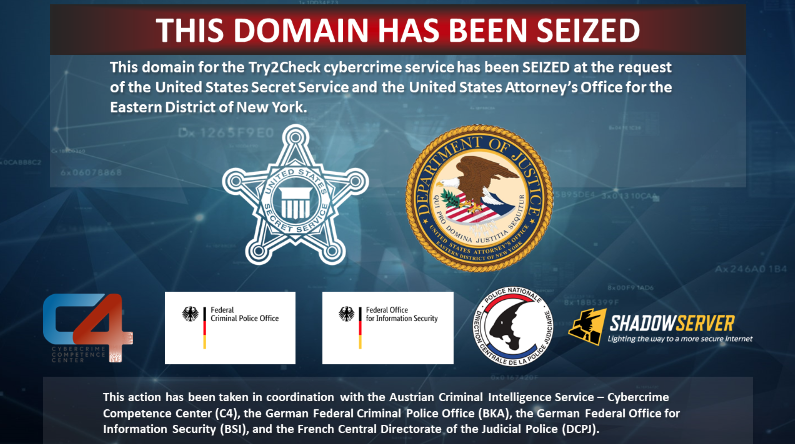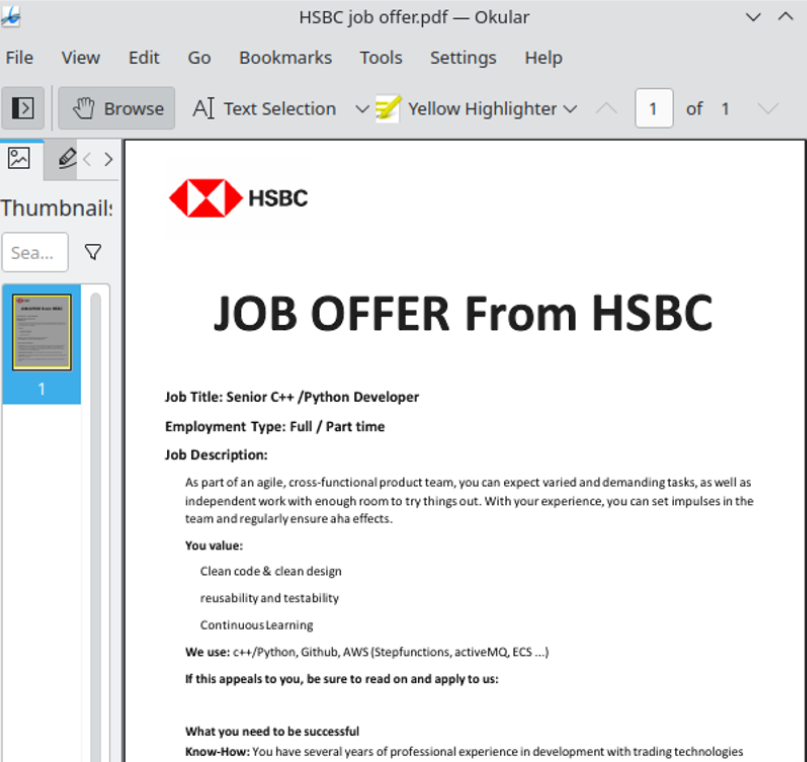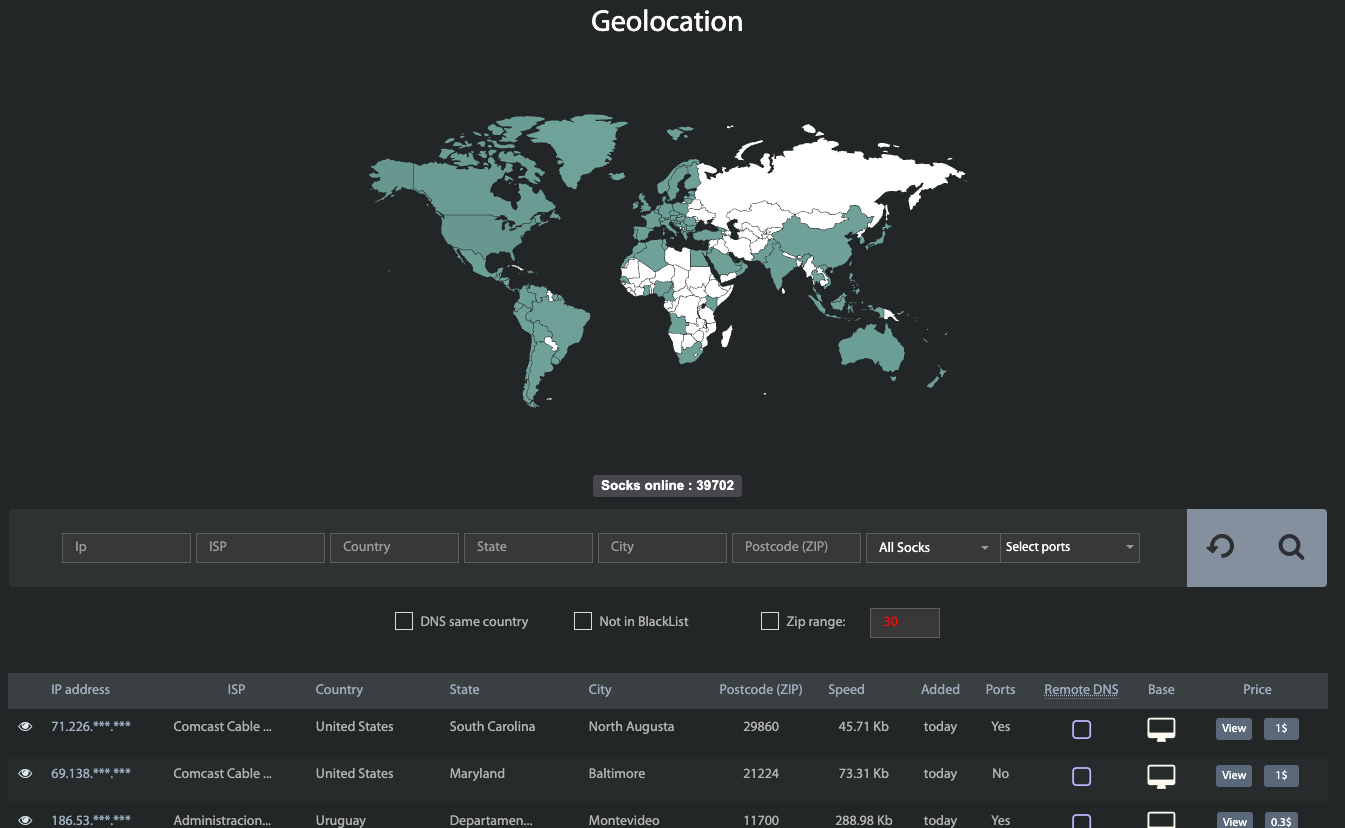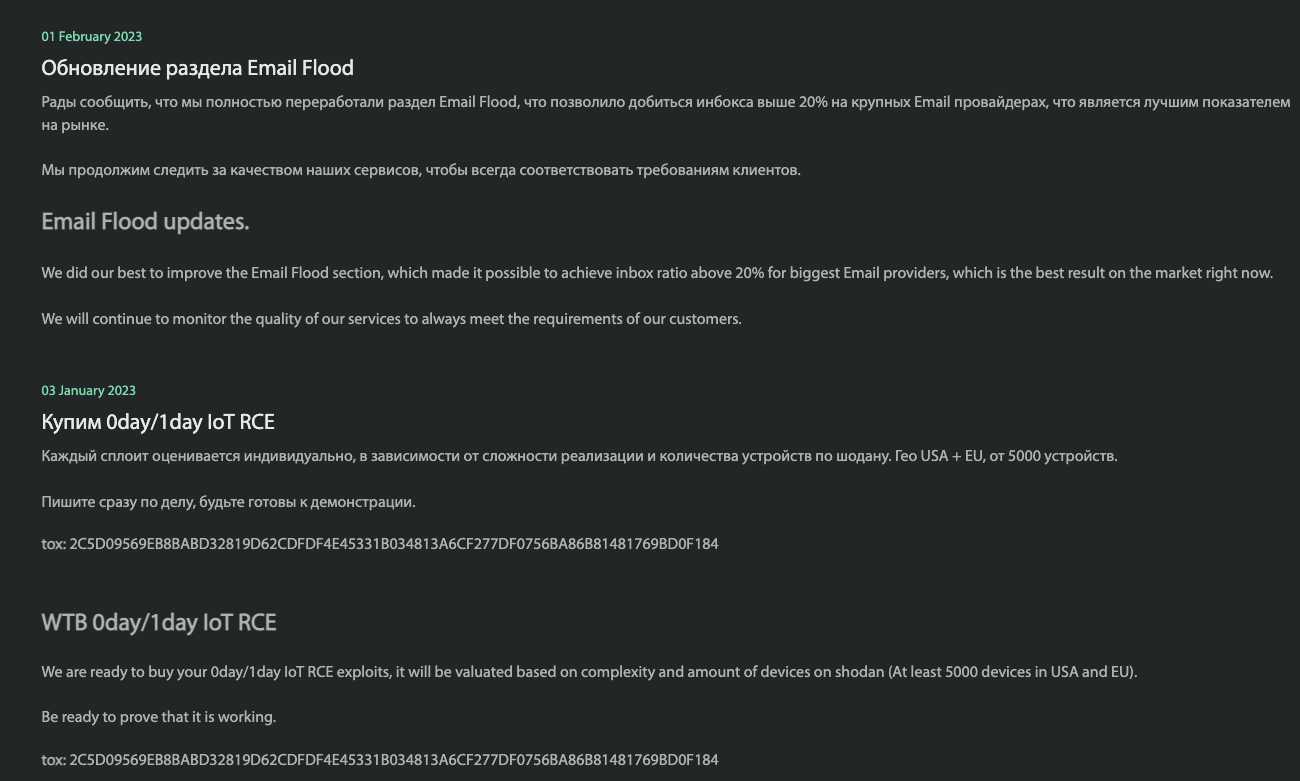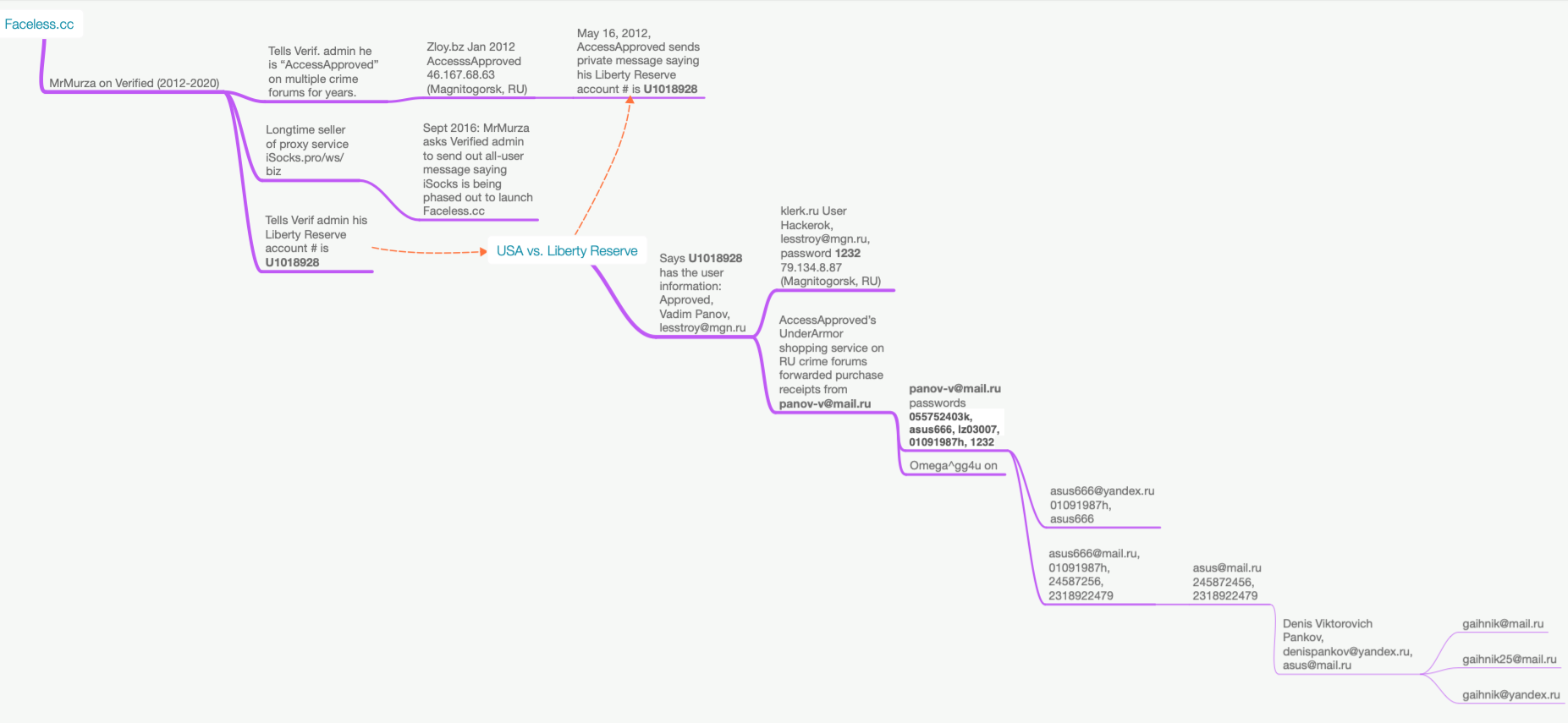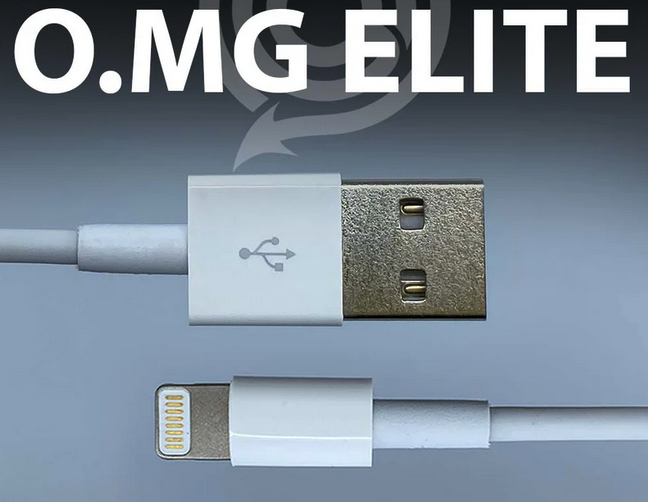A sprawling online company based in Georgia that has made tens of millions of dollars purporting to sell access to jobs at the United States Postal Service (USPS) has exposed its internal IT operations and database of nearly 900,000 customers. The leaked records indicate the network’s chief technology officer in Pakistan has been hacked for the past year, and that the entire operation was created by the principals of a Tennessee-based telemarketing firm that has promoted USPS employment websites since 2016.

The website FederalJobsCenter promises to get you a job at the USPS in 30 days or your money back.
KrebsOnSecurity was recently contacted by a security researcher who said he found a huge tranche of full credit card records exposed online, and that at first glance the domain names involved appeared to be affiliated with the USPS.
Further investigation revealed a long-running international operation that has been emailing and text messaging people for years to sign up at a slew of websites that all promise they can help visitors secure employment at the USPS.
Sites like FederalJobsCenter[.]com also show up prominently in Google search results for USPS employment, and steer applicants toward making credit card “registration deposits” to ensure that one’s application for employment is reviewed. These sites also sell training, supposedly to help ace an interview with USPS human resources.
FederalJobsCenter’s website is full of content that makes it appear the site is affiliated with the USPS, although its “terms and conditions” state that it is not. Rather, the terms state that FederalJobsCenter is affiliated with an entity called US Job Services, which says it is based in Lawrenceville, Ga.
“US Job Services provides guidance, coaching, and live assistance to postal job candidates to help them perform better in each of the steps,” the website explains.
The site says applicants need to make a credit card deposit to register, and that this amount is refundable if the applicant is not offered a USPS job within 30 days after the interview process.
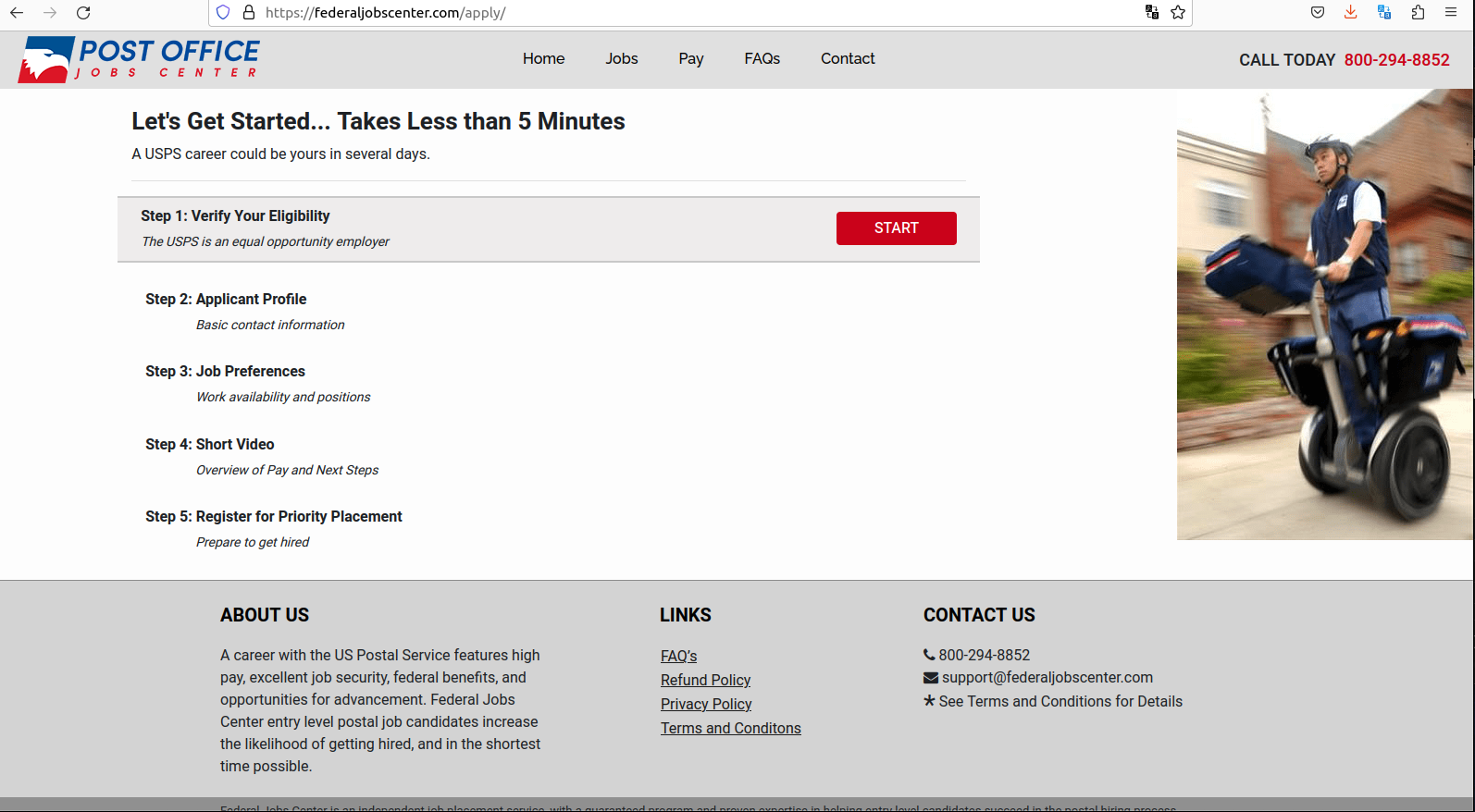
But a review of the public feedback on US Job Services and dozens of similar names connected to this entity over the years shows a pattern of activity: Applicants pay between $39.99 and $100 for USPS job coaching services, and receive little if anything in return. Some reported being charged the same amount monthly.
The U.S. Federal Trade Commission (FTC) has sued several times over the years to disrupt various schemes offering to help people get jobs at the Postal Service. Way back in 1998, the FTC and the USPS took action against several organizations that were selling test or interview preparation services for potential USPS employees.
“Companies promising jobs with the U.S. Postal Service are breaking federal law,” the joint USPS-FTC statement said.
In that 1998 case, the defendants behind the scheme were taking out classified ads in newspapers. Ditto for a case the FTC brought in 2005. By 2008, the USPS job exam preppers had shifted to advertising their schemes mostly online. And in 2013, the FTC won a nearly $5 million judgment against a Kentucky company purporting to offer such services.
Tim McKinlay authored a report last year at Affiliateunguru.com on whether the US Job Services website job-postal[.]com was legitimate or a scam. He concluded it was a scam based on several factors, including that the website listed multiple other names (suggesting it had recently switched names), and that he got nothing from the transaction with the job site.
“They openly admit they’re not affiliated with the US Postal Service, but claim to be experts in the field, and that, just by following the steps on their site, you easily pass the postal exams and get a job in no time,” McKinlay wrote. “But it’s really just a smoke and mirrors game. The site’s true purpose is to collect $46.95 from as many people as possible. And considering how popular this job is, they’re probably making a killing.”
US JOB SERVICES
KrebsOnSecurity was alerted to the data exposure by Patrick Barry, chief information officer at Charlotte, NC based Rebyc Security. Barry said he found that not only was US Job Services leaking its customer payment records in real-time and going back to 2016, but its website also leaked a log file from 2019 containing the site administrator’s contact information and credentials to the site’s back-end database.
Barry shared screenshots of that back-end database, which show the email address for the administrator of US Job Services is tab.webcoder@gmail.com. According to cyber intelligence platform Constella Intelligence, that email address is tied to the LinkedIn profile for a developer in Karachi, Pakistan named Muhammed Tabish Mirza.
A search on tab.webcoder@gmail.com at DomainTools.com reveals that email address was used to register several USPS-themed domains, including postal2017[.]com, postaljobscenter[.]com and usps-jobs[.]com.
Mr. Mirza declined to respond to questions, but the exposed database information was removed from the Internet almost immediately after KrebsOnSecurity shared the offending links.
A “Campaigns” tab on that web panel listed several advertising initiatives tied to US Job Services websites, with names like “walmart drip campaign,” “hiring activity due to virus,” “opt-in job alert SMS,” and “postal job opening.”
Another page on the US Job Services panel included a script for upselling people who call in response to email and text message solicitations, with an add-on program that normally sells for $1,200 but is being “practically given away” for a limited time, for just $49.
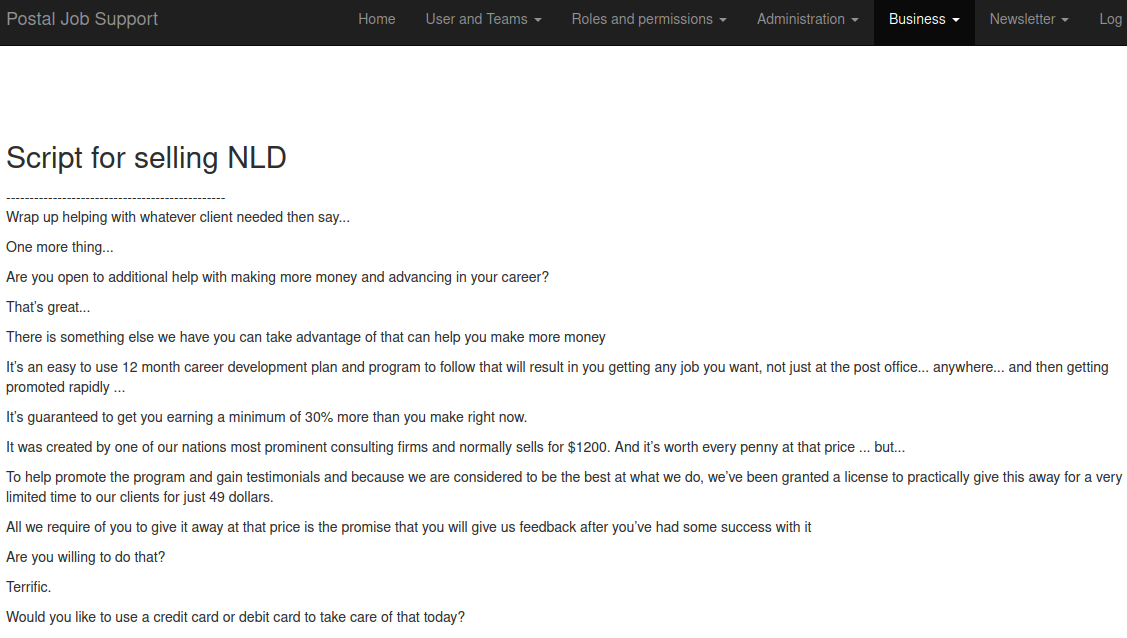
An upselling tutorial for call center employees.
“There’s something else we have you can take advantage of that can help you make more money,” the script volunteers. “It’s an easy to use 12-month career development plan and program to follow that will result in you getting any job you want, not just at the post office….anywhere…and then getting promoted rapidly.”
It’s bad enough that US Job Services was leaking customer data: Constella Intelligence says the email address tied to Mr. Mirza shows up in more than a year’s worth of “bot logs” created by a malware infection from the Redline infostealer.
Constella reports that for roughly a year between 2021 and 2022, a Microsoft Windows device regularly used by Mr. Mirza and his colleagues was actively uploading all of the device’s usernames, passwords and authentication cookies to cybercriminals based in Russia.
NEXT LEVEL SUPPORT
The web-based backend for US Job Services lists more than 160 people under its “Users & Teams” tab. This page indicates that access to the consumer and payment data collected by US Job Services is currently granted to several other coders who work with Mr. Mirza in Pakistan, and to multiple executives, contractors and employees working for a call center in Murfreesboro, Tennessee.
The call center — which operates as Nextlevelsupportcenters[.]com and thenextlevelsupport[.]com — curiously has several key associates with a history of registering USPS jobs-related domain names.
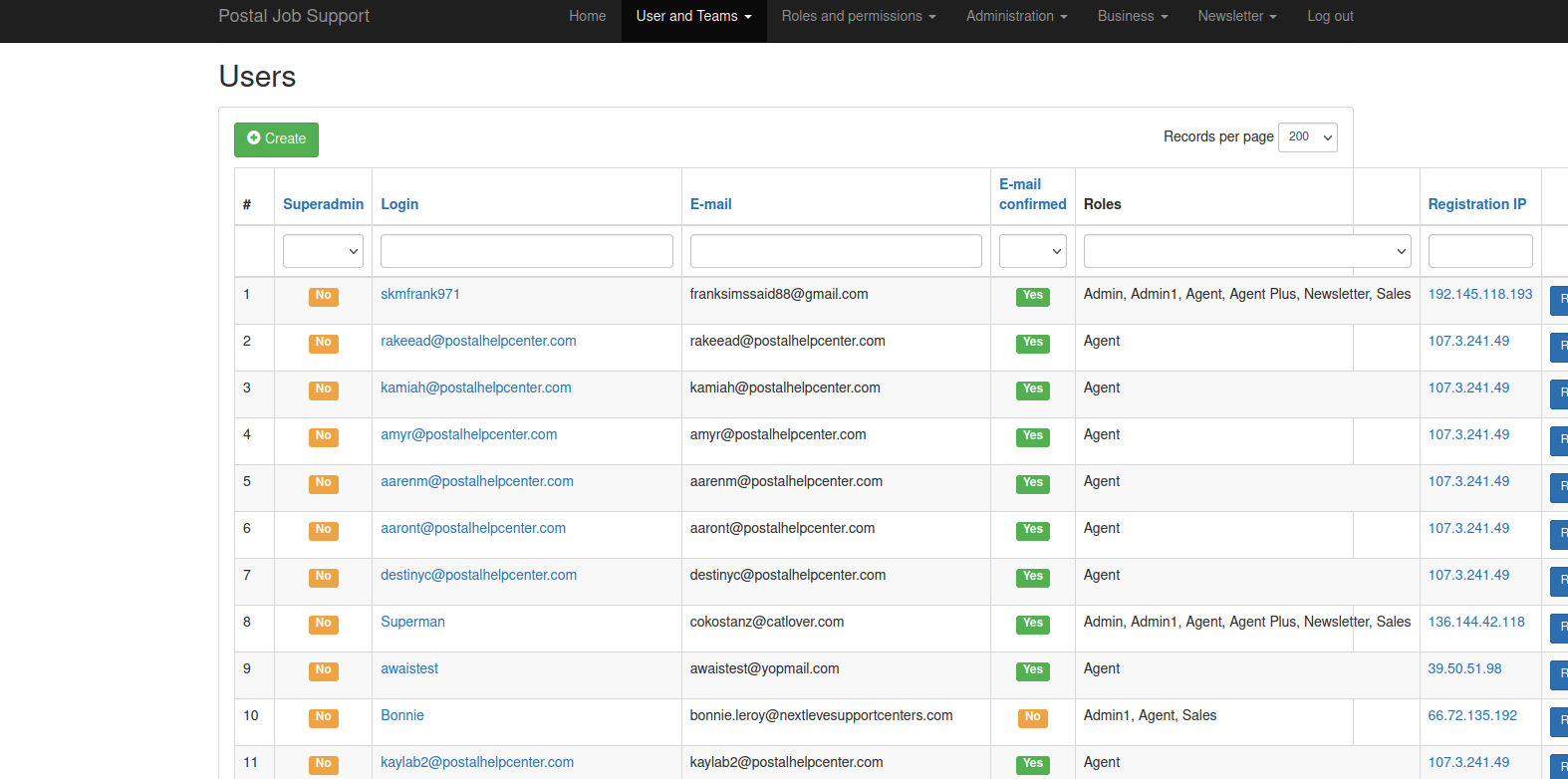
The US Job Services website has more than 160 users, including most of the employees at Next Level Support.
The website for NextLevelSupport says it was founded in 2017 by a Gary Plott, whose LinkedIn profile describes him as a seasoned telecommunications industry expert. The leaked backend database for US Job Services says Plott is a current administrator on the system, along with several other Nextlevel founders listed on the company’s site.
Reached via telephone, Plott initially said his company was merely a “white label” call center that multiple clients use to interact with customers, and that the content their call center is responsible for selling on behalf of US Job Services was not produced by NextLevelSupport.
“A few years ago, we started providing support for this postal product,” Plott said. “We didn’t develop the content but agreed we would support it.”
Interestingly, DomainTools says the Gmail address used by Plott in the US Jobs system was also used to register multiple USPS job-related domains, including postaljobssite[.]com, postalwebsite[.]com, usps-nlf[.]com, usps-nla[.]com.
Asked to reconcile this with his previous statement, Plott said he never did anything with those sites but acknowledged that his company did decide to focus on the US Postal jobs market from the very beginning.
Plott said his company never refuses to issue a money-back request from a customer, because doing so would result in costly chargebacks for NextLevel (and presumably for the many credit card merchant accounts apparently set up by Mr. Mirza).
“We’ve never been deceptive,” Plott said, noting that customers of the US Job Services product receive a digital download with tips on how to handle a USPS interview, as well as unlimited free telephone support if they need it.
“We’ve never told anyone we were the US Postal Service,” Plott continued. “We make sure people fully understand that they are not required to buy this product, but we think we can help you and we have testimonials from people we have helped. But ultimately you as the customer make that decision.”
An email address in the US Job Services teams page for another user — Stephanie Dayton — was used to register the domains postalhiringreview[.]com, and postalhiringreviewboard[.]org back in 2014. Reached for comment, Ms. Dayton said she has provided assistance to Next Level Support Centers with their training and advertising, but never in the capacity as an employee.
Perhaps the most central NextLevel associate who had access to US Job Services was Russell Ramage, a telemarketer from Warner Robins, Georgia. Ramage is listed in South Carolina incorporation records as the owner of a now-defunct call center service called Smart Logistics, a company whose name appears in the website registration records for several early and long-running US Job Services sites.

According to the state of Georgia, Russell Ramage was the registered agent of several USPS job-themed companies.
The leaked records show the email address used by Ramage also registered multiple USPS jobs-related domains, including postalhiringcenter[.]com, postalhiringreviews[.]com, postaljobs-email[.]com, and postaljobssupport1[.]com.
A review of business incorporation records in Georgia indicate Ramage was the registered agent for at least three USPS-related companies over the years, including Postal Career Placement LLC, Postal Job Services Inc., and Postal Operations Inc. All three companies were founded in 2015, and are now dissolved.
An obituary dated February 2023 says Russell Ramage recently passed away at the age of 41. No cause of death was stated, but the obituary goes on to say that Russ “Rusty” Ramage was “preceded in death by his mother, Anita Lord Ramage, pets, Raine and Nola and close friends, Nicole Reeves and Ryan Rawls.”
In 2014, then 33-year-old Ryan “Jootgater” Rawls of Alpharetta, Georgia pleaded guilty to conspiring to distribute controlled substances. Rawls also grew up in Warner Robins, and was one of eight suspects charged with operating a secret darknet narcotics ring called the Farmer’s Market, which federal prosecutors said trafficked in millions of dollars worth of controlled substances.
Reuters reported that an eighth suspect in that case had died by the time of Rawls’ 2014 guilty plea, although prosecutors declined to offer further details about that. According to his obituary, Ryan Christopher Rawls died at the age of 38 on Jan. 28, 2019.
In a comment on Ramage’s memorial wall, Stephanie Dayton said she began working with Ramage in 2006.
“Our friendship far surpassed a working one, we had a very close bond and became like brother and sister,” Dayton wrote. “I loved Russ deeply and he was like family. He was truly one of the best human beings I have ever known. He was kind and sweet and truly cared about others. Never met anyone like him. He will be truly missed. RIP brother.”
The FTC and USPS note that while applicants for many entry-level postal jobs are required to take a free postal exam, the tests are usually offered only every few years in any particular district, and there are no job placement guarantees based on score.
“If applicants pass the test by scoring at least 70 out of 100, they are placed on a register, ranked by their score,” the FTC explained. “When a position becomes open, the local post office looks to the applicable register for that geographic location and calls the top three applicants. The score is only one of many criteria taken into account for employment. The exams test general aptitude, something that cannot necessarily be increased by studying.”
The FTC says anyone interested in a job at the USPS should inquire at their local postal office, where applicants generally receive a free packet of information about required exams. More information about job opportunities at the postal service is available at the USPS’s careers website.
Michael Martel, spokesperson for the United States Postal Inspection Service, said in a written statement that the USPS has no affiliation with the websites or companies named in this story.
“To learn more about employment with USPS, visit USPS.com/careers,” Martel wrote. “If you are the victim of a crime online report it to the FBI’s Internet Crime Complaint Center (IC3) at www.ic3.gov. To report fraud committed through or toward the USPS, its employees, or customers, report it to the United States Postal Inspection Service (USPIS) at www.uspis.gov/report.”
According to the leaked back-end server for US Job Services, here is a list of the current sites selling this product:
usjobshelpcenter[.]com
usjobhelpcenter[.]com
job-postal[.]com
localpostalhiring[.]com
uspostalrecruitment[.]com
postalworkerjob[.]com
next-level-now[.]com
postalhiringcenters[.]com
postofficehiring[.]com
postaljobsplacement[.]com
postal-placement[.]com
postofficejobopenings[.]com
postalexamprep[.]com
postaljobssite[.]com
postalwebsite[.]com
postalcareerscenters[.]com
postal-hiring[.]com
postal-careers[.]com
postal-guide[.]com
postal-hiring-guide[.]com
postal-openings[.]com
postal-placement[.]com
postofficeplacements[.]com
postalplacementservices[.]com
postaljobs20[.]com
postal-jobs-placement[.]com
postaljobopenings[.]com
postalemployment[.]com
postaljobcenters[.]com
postalmilitarycareers[.]com
epostaljobs[.]com
postal-job-center[.]com
postalcareercenter[.]com
postalhiringcenters[.]com
postal-job-center[.]com
postalcareercenter[.]com
postalexamprep[.]com
postalplacementcenters[.]com
postalplacementservice[.]com
postalemploymentservices[.]com
uspostalhiring[.]com



